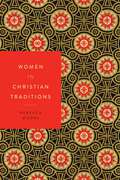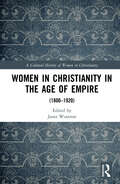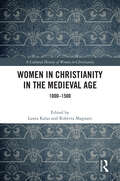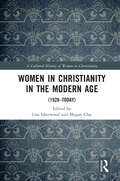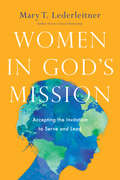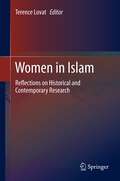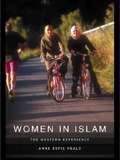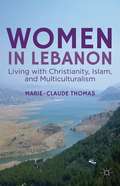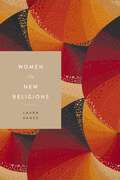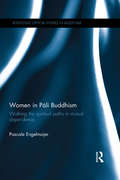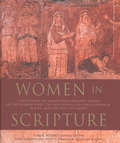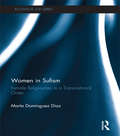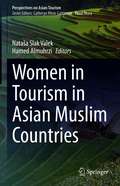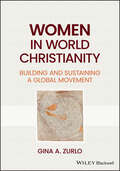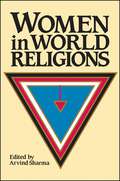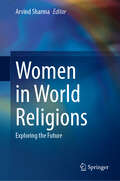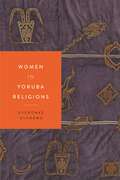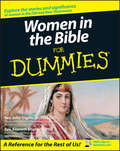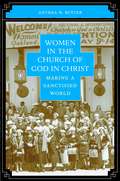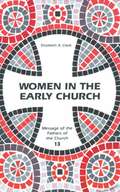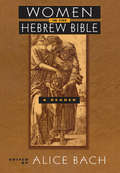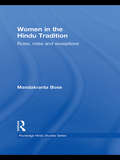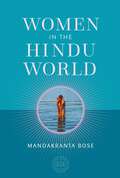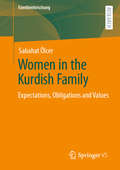- Table View
- List View
Women in Christian Traditions (Women in Religions #2)
by Rebecca MooreUncovers women's participation and impact on defining historical moments and themes of Christian traditionsWomen in Christian Traditions offers a concise and accessible examination of the roles women have played in the construction and practice of Christian traditions, revealing the enormous debt that this major world religion owes to its female followers. It recovers forgotten and obscured moments in church history to help us to realize a richer and fuller understanding of Christianity.This text provides an overview of the complete sweep of Christian history through the lens of feminist scholarship. Yet it also departs from some of the assumptions of that scholarship, raising questions that challenge our thinking about how women have shaped beliefs and practices during two thousand years of church history. Did the emphasis on virginity in the early church empower Christian women? Did the emphasis on marriage during the Reformations of the sixteenth century improve their status? These questions and others have important implications for women in Christianity in particular, and for women in religion in general, since they go to the heart of the human condition.This work examines themes, movements, and events in their historical contexts and locates churchwomen within the broader developments that have been pivotal in the evolution of Christianity. From the earliest disciples to the latest theologians, from the missionaries to the martyrs, women have been instrumental in keeping the faith alive. Women in Christian Traditions shows how they did so.
Women in Christianity in the Age of Empire: (1800–1920) (A Cultural History of Women in Christianity)
by Janet WoottonWomen in Christianity in the Age of Empire (1800–1920) offers a broad view of the nineteenth century as a time of dramatic change, particularly for women, critiqued in the light of postcolonial theory. This edited volume includes important contributions from academics in the field. Overarching themes include the cult of domesticity, the changing impact of Christianity on views of women’s nature in an age of scientific thinking, conflation of ‘gospel’ and ‘civilization’ in global mission, and the exclusion of women from public spheres of life. We meet powerful saints, campaigners, and thinkers, who bring about genuine transformation in the lives of women, and in society. But we also recognize the long shadow of Empire in the world of the twenty-first century, critiquing Colonialism and Empire, and views that restricted women’s lives. This engaging volume will be of key interest to students and scholars in Religion and Cultural Studies. Exploring the complexities of the nineteenth centur,y it draws on a range of scholarship, including TV documentaries, film, online, and more traditional academic resources.
Women in Christianity in the Medieval Age: 1000–1500 (A Cultural History of Women in Christianity)
by Laura Kalas Roberta MagnaniThis volume offers a comprehensive introduction to and investigation of the multivocality of women’s experience in the Middle Ages. In medieval Europe women saw their role in the Christian Church and society progressively confined to conflicting models of femininity epitomised by the dichotomy of Eve/Mary. Classical views of gender, predicated on misogynistic dichotomies which confined women to matter and the corruption of the flesh, were consolidated in powerful male-dominated clerical institutions and widely disseminated. Towards the end of the Middle Ages, however, women’s corporeality and somatic spirituality contributed to and influenced burgeoning modes of piety centred around the cult of the Virgin Mary and the veneration of the suffering body of Christ on the Cross. This shift in devotional practices afforded women as bodily beings the space for an increased level of self-expression, self-realisation, and authority. Ranging from philosophical and theological enquiry to education and art, as well as medical sciences and popular beliefs, the essays in this collection account for the complexities and richness of the conceptualisations and lived experiences of medieval Christian women. The book will be especially relevant to students and scholars of religion and history with an interest in medieval studies and gender. Whilst expounding the key strands of thinking in the field, it engages with and contributes to some of the latest scholarly research.
Women in Christianity in the Modern Age: (1920-today) (A Cultural History of Women in Christianity)
by Lisa IsherwoodWomen in Christianity in the Modern Age examines the role of women in Christianity in the 20th and early 21st Centuries. This edited volume includes eight important contributions from academics in the field. The modern era has been an age of social and religious upheaval, and the ravages of global warfare and changes to women’s role in society have made the examination of the place of women in religion a key question in theology. From theological concerns - engagements with the biblical texts by feminist and anti-feminist theologians, the modern role of Mary and women saints – to political and social debates on women’s ministry and place in society, and cultural shifts as expressed through theologically inspired artwork by women, Women in Christianity in the Modern Age provides an overview and in-depth studies of a tumultuous and changing era. This insightful text will be of key interest to students and scholars in Religion and Cultural Studies.
Women in Convent Spaces and the Music Networks of Early Modern Barcelona (Routledge Research in Music)
by Ascensión Mazuela-AnguitaThis book presents the first study of music in convent life in a single Hispanic city, Barcelona, during the early modern era. Exploring how convents were involved in the musical networks operating in sixteenth-century Barcelona, it challenges the invisibility of women in music history and reveals the intrinsic role played by nuns and lay women in the city’s urban musical culture. Drawing on a wide range of archival sources, this innovative study offers a cross-disciplinary approach that not only reveals details of the rich musical life in Barcelona’s nunneries, but shows how they took part in wider national and transnational networks of musical distribution, including religious, commercial, and social dimensions of music. The connections of Barcelona convents to networks for the dissemination of music in and outside the city provide a rich example of the close relationship between musical networks, urban society, and popular culture. Addressing how music was understood as a marker of identity, prestige, and social status and, above all, as a conduit between earth and heaven, this book provides new insights into how women shaped musical traditions in the urban context. It is essential reading for scholars of early modern history, musicology, history of religion, and gender studies, as well as all those with an interest in urban history and the city of Barcelona. The book is supported by additional digital appendices, which include: Records of inquiries into the lineage of Santa Maria de Jonqueres nuns Development of the collections of choir books belonging to the convents of Santa Maria de Jonqueres and Sant Antoni i Santa Clara
Women in God's Mission: Accepting the Invitation to Serve and Lead
by Mary T. LederleitnerWomen have advanced God's mission throughout history and around the world. But women often face particular obstacles in ministry. What do we need to know about how women thrive?
Women in Islam
by Terence LovatThe role of women in Islamic societies, not to mention in the religion itself, is a defining issue. It is also one that remains resistant to universal dogma, with a wide range of responses to women's social roles across the Islamic world. Reflecting this heterogeneity, the editor of this volume has assembled the latest research on the issue, which combines contemporary with historical data. The material comes from around the world as well as from Muslim and non-Muslim researchers. It takes in work from majority Muslim nations such as Bangladesh, Iran, Iraq, Lebanon, Pakistan, Palestine, Tunisia and Turkey, as well as countries with troubled interfaith relations such as India and Israel. Nations with minority Muslim populations such as France, the UK, Canada and Australia, are also represented. The work also features varying Islamic sub-groups such as the two main ones, Sunni and Shi'a, as well as less well known populations such as the Ismaili Muslims. In each case, the work is underpinned by the very latest socio-theological insights and empirical data.
Women in Islam: The Western Experience
by Anne-Sofie RoaldWomen in Islam investigates the ongoing debate across the Muslim world and the West on the position of women in Islam.Anne-Sofie Roald focuses on how Islamic perceptions of women and gender change in Western Muslim communities. She shows how Islamic attitudes towards social concerns such as gender relations, female circumcision, and female dress emerge as responsive to culture and context, rather than rigid and inflexible.
Women in Lebanon
by Marie-Claude ThomasCombining insider and outsider perspectives, Women in Lebanon looks at Christian and Muslim women living together in a multicultural society and facing modernity. While the Arab Spring has begun to draw attention to issues of change, modernity, and women's subjectivity, this manuscript takes a unique approach to examining and describing the Lebanese "alternative modernities" thesis and how it has shaped thinking about the meaning of terms like evolution, progress, development, history, and politics in contemporary Arab thought. The author draws on extensive ethnographic research, as well as her own personal experience.
Women in New Religions (Women in Religions #3)
by Laura VanceWomen in New Religions offers an engaging look at women's evolving place in the birth and development of new religious movements. It focuses on four disparate new religions--Mormonism, Seventh-day Adventism, The Family International, and Wicca--to illuminate their implications for gender socialization, religious leadership and participation, sexuality, and family ideals. Religious worldviews and gender roles interact with one another in complicated ways. This is especially true within new religions, which frequently set roles for women in ways that help the movements to define their boundaries in relation to the wider society. As new religious movements emerge, they often position themselves in opposition to dominant society and concomitantly assert alternative roles for women. But these religions are not monolithic: rather than defining gender in rigid and repressive terms, new religions sometimes offer possibilities to women that are not otherwise available. Vance traces expectations for women as the religions emerge, and transformation of possibilities and responsibilities for women as they mature. Weaving theory with examination of each movement's origins, history, and beliefs and practices, this text contextualizes and situates ideals for women in new religions. The book offers an accessible analysis of the complex factors that influence gender ideology and its evolution in new religious movements, including the movements' origins, charismatic leadership and routinization, theology and doctrine, and socio-historical contexts. It shows how religions shape definitions of women's place in a way that is informed by response to social context, group boundaries, and identity. Additional Resources
Women in Pāli Buddhism: Walking the Spiritual Paths in Mutual Dependence (Routledge Critical Studies in Buddhism)
by Pascale EngelmajerThe Pāli tradition presents a diverse and often contradictory picture of women. This book examines women’s roles as they are described in the Pāli canon and its commentaries. Taking into consideration the wider socio-religious context and drawing from early brahmanical literature and epigraphical findings, it contrasts these descriptions with the doctrinal account of women’s spiritual abilities. The book explores gender in the Pāli texts in order to delineate what it means to be a woman both in the context in which the texts were composed and in the context of their ultimate goal - that of achieving escape from the round of rebirths. The critical investigation focuses on the internal relationships and dynamics of one tradition and employs a novel methodology, which the author calls "critical sympathy". This assumes that the tradition’s teaching is valid for all, in particular that its main goal, nibbāṇa, is accessible to all human beings. By considering whether and how women’s roles fit within this path, the author examines whether women have spiritual agency not only as bhikkhunīs (Buddhist nuns), but also as wives and mothers. It offers a new understanding that focuses on how the tradition construes women’s traditional roles within an interdependent community. It aims to understand how what many scholars have seen as contradictory and inconsistent characterizations of women in Buddhism have been accepted and endorsed by the Pāli tradition. With an aim to show that the Pāli canon offers an account of women that is doctrinally coherent and consistent with its sociological facts, this book will be of interest to students and scholars of Buddhism and Asian Religion.
Women in Scripture: A Dictionary of Named and Unnamed Women in the Hebrew Bible, the Apocryphal/Deuterocanonical Books and the New Testament
by Toni Craven Carol Meyers Ross S. Kraemer&“This splendid reference describes every woman in Jewish and Christian scripture . . . monumental&” (Library Journal). In recent decades, many biblical scholars have studied the holy text with a new focus on gender. Women in Scripture is a groundbreaking work that provides Jews, Christians, or anyone fascinated by a body of literature that has exerted a singular influence on Western civilization a thorough look at every woman and group of women mentioned in the Bible, whether named or unnamed, well known or heretofore not known at all. They are remarkably varied—from prophets to prostitutes, military heroines to musicians, deacons to dancers, widows to wet nurses, rulers to slaves. There are familiar faces, such as Eve, Judith, and Mary, seen anew with the full benefit of the most up-to-date results of biblical scholarship. But the most innovative aspect of this book is the section devoted to the many females who in the scriptures do not even have names. Combining rigorous research with engaging prose, these articles on women in the Hebrew Bible, the Apocryphal/Deuterocanonical Books, and the New Testament will inform, delight, and challenge readers interested in the Bible, scholars and laypeople alike. Together, these collected histories create a volume that takes the study of women in the Bible to a new level.
Women in Sufism: Female Religiosities in a Transnational Order (Routledge Sufi Series)
by Marta Dominguez DiazExploring the diverse myriad of female religious identities that exist within the various branches of the Moroccan Sufi Order, Qādiriyya Būdshīshiyya, today, this book evidences a wide array of religious identities, from those more typical of Berber culture, to those characterised by a ‘sober’ approach to Sufism, as well as those that denote New Age eclecticism. The book researches the ways in which religious discourses are corporeally endorsed. After providing an overview of the Order historically and today, enunciating the processes by which this local tarīqa from North-eastern Morocco has become the international organization that it is now, the book explores the religious body in movement, in performance, and in relation to the social order. It analyses pilgrimage by assessing the annual visit that followers of Hamza Būdshīsh make to the central lodge of the Order in Madāgh; it explores bodily religious enactments in ritual performance, by discussing the central practices of Sufi ritual as manifested in the Būdshīshiyya, and delves attention into diverse understandings of faith healing and health issues. Women and Sufism provides a detailed insight into religious healing, sufi rituals and sufi pilgrimage, and is essential reading for those seeking to understand Islam in Morocco, or those with an interest in Anthropology and Middle East studies more generally.
Women in Tourism in Asian Muslim Countries (Perspectives on Asian Tourism)
by Nataša Slak Valek Hamed AlmuhrziThis book focuses on women in tourism in Muslim countries, specifically where a woman can be seen as a tourism consumer, or a woman producing tourism. This book discusses the role of women in the Muslim world and founds that socio-culturally Islam has a greater impact on women than men. The process of identity construction and the religious values of women have also been extensively researched. But little is known about the role of Muslim women in the tourism industry and this book addresses these themes in the Asian context. This book explores these ideas as defined key categories; Muslim women from Asia travelling to a non-Muslim country, non-Muslim women travelling to Asian Muslim countries, and Women working in the tourism field in Muslim countries. This book highlights Asian countries as holding a complex mixture of cultures and identities. As Muslim communities are central in many Asian countries the tourism experience is different mainly because of cultural norms and religion. Ultimately, this book examines whether and how these complexities enrich both women and tourism industry within Asian context.
Women in World Christianity: Building and Sustaining a Global Movement
by Gina A. ZurloA groundbreaking, comprehensive, and interdisciplinary analysis of women’s experiences in World Christianity Women in World Christianity: Building and Sustaining a Global Movement is the first textbook to focus on women’s experiences in the founding, spread, and continuation of the Christian faith. Integrating historical, theological, and social scientific approaches to World Christianity, this innovative volume centers women’s perspectives to illustrate their key role in Christianity becoming a world religion, including how they sustain the faith in the present and their expanding role in the future. Women in World Christianity features findings from the Women in World Christianity Project, a groundbreaking study that produced the first quantitative dataset on gender in every Christian denomination in every country of the world. Throughout the text, special emphasis is placed on women in the twentieth and twenty-first centuries, the period of Christianity’s shift from the global North to the global South. Easily accessible chapters – organized by continent, tradition, and select topics – introduce students to the wide variety of Christian belief and practice around the world. The book also discusses issues specifically relevant to women in the church: gender-based violence, ecology, theological education, peacebuilding and more. This textbook: Provides a balanced view of women’s involvement in Christianity as a world religion and how they sustain the faith today Introduces students to female theologians around the world whose scholarship is generally overlooked in Western theological education Discusses women’s essential contributions to Christian mission, leadership, education, relief work, healthcare, and other social services of the church Complements the growing body of literature about Christian women from different continental, regional, national, and ecclesiastical perspectives Explores the contributions of contemporary Christian women of all major denominations in Africa, Asia, Europe, Latin America, North America, and Oceania Helps students become more aware of the unique challenges women face worldwide, and what they are doing to overcome themWomen in World Christianity: Building and Sustaining a Global Movement is an excellent primary textbook for introductory courses on World Christianity, History of Christianity, World Religions, Gender in Religion, as well as undergraduate and graduate courses specifically focused on women in World Christianity.
Women in World Religions (SUNY series, McGill Studies in the History of Religions, A Series Devoted to International Scholarship)
by Arvind Sharma Katherine K. YoungThis is a book by women about women in the religions of the world. It presents all the basic facts and ideological issues concerning the position of women in the major religious traditions of humanity: Buddhism, Christianity, Confucianism, Hinduism, Islam, Judaism, Taoism, and tribal religions.A special feature of the book is its phenomenological approach, wherein scholars examine sacred textual materials. Each contributor not only studies her religion from within, but also studies it from her own feminine perspective. Each is an adept historian of religions, who grounds her analysis in publicly verifiable facts. The book strikes a delicate balance between hard fact and delicate perception, the best tradition of phenomenology and the history of religions. It also demonstrates how much religions may vary over time.Contributors are Katherine K. Young, Associate Professor of Religious Studies at McGill University; Nancy Schuster Barnes, whose Ph.D. is in Sanskrit and Indian Studies; M. Theresa Kelleher, Assistant Professor of Religion and Asian Studies at Manhattanville College; Barbara Reed, Assistant Professor of Religion at St. Olaf College; Denise L. Carmody, Professor and Chair, Department of Religion, The University of Tulsa. Also Jane I. Smith, Associate Dean for Academic Affairs and Lecturer in Islamic Studies at Harvard Divinity School; Rosemary Radford Ruether, Georgia Harkness Professor of Applied Theology at the Garrett-Evangelical Theological Seminary; Rita M. Gross, Associate Professor of Comparative Religions at the University of Wisconsin, Eau Clair.
Women in World Religions: Exploring the Future
by Arvind SharmaThis book delves into the future of the relationship between religion and the status of women. With contributions from distinguished scholars, it examines current trends in the following religions: Judaism, Christianity, Islam, Hinduism, Buddhism, Jainism, Sikhism, Confucianism, and Daoism. It envisions the implications of these developments for the future position of women. The method employed in this book is characterized by what is known as 'personalist epistemology.' The contributing authors blend their experiences as women within the diverse traditions, along with more comprehensive accounts of the role of women in these religions. By doing so, they combine the finest aspects of subjective and objective approaches to studying women in world religions. The contributors examine contemporary trends within their respective religious traditions by combining the finest aspects of subjective and objective approaches to studying women in world religions. It serves as a testament to the enduring interest in women's roles in religion and the dynamic nature of the field. The book intends to appeal to many readers, from the general public to academics. It offers valuable insights into the position of women in world religions, making it relevant to both the average person and those engaged in scholarly pursuits.
Women in Yoruba Religions (Women in Religions)
by Oyèrónké Oládém?Uncovers the influence of Yoruba culture on women’s religious lives and leadership in religions practiced by Yoruba people Women in Yoruba Religions examines the profound influence of Yoruba culture in Yoruba religion, Christianity, Islam, and Afro-Diasporic religions such as Santeria and Candomblé, placing gender relations in historical and social contexts. While the coming of Christianity and Islam to Yorubaland has posed significant challenges to Yoruba gender relations by propagating patriarchal gender roles, the resources within Yoruba culture have enabled women to contest the full acceptance of those new norms. Oyeronke Olademo asserts that Yoruba women attain and wield agency in family and society through their economic and religious roles, and Yoruba operate within a system of gender balance, so that neither of the sexes can be subsumed in the other. Olademo utilizes historical and phenomenological methods, incorporating impressive data from interviews and participant-observation, showing how religion is at the core of Yoruba lived experiences and is intricately bound up in all sectors of daily life in Yorubaland and abroad in the diaspora.
Women in the Bible For Dummies
by Rev Kenneth Brighenti Rev John TrigilioComprehensive interfaith coverage of the important female figures This friendly, approachable guide introduces readers to the famous and infamous women of Scripture, describing in everyday language the contributions these women made in their time and ours. From Eve, Sarah, and Esther to Mary and Mary Magdalene, it discusses well-known women of both the Old and New Testaments, examining their role in Biblical narratives, their place in the Jewish and Christian faiths, and the lessons their stories impart to women today.
Women in the Church of God in Christ
by Anthea D. ButlerThe Church of God in Christ (COGIC), an African American Pentecostal denomination founded in 1896, has become the largest Pentecostal denomination in the United States today. In this first major study of the church, Anthea Butler examines the religious and social lives of the women in the COGIC Women's Department from its founding in 1911 through the mid-1960s. She finds that the sanctification, or spiritual purity, that these women sought earned them social power both in the church and in the black community.Offering rich, lively accounts of the activities of the Women's Department founders and other members, Butler shows that the COGIC women of the early decades were able to challenge gender roles and to transcend the limited responsibilities that otherwise would have been assigned to them both by churchmen and by white-dominated society. The Great Depression, World War II, and the civil rights movement brought increased social and political involvement, and the Women's Department worked to make the "sanctified world" of the church interact with the broader American society. More than just a community of church mothers, says Butler, COGIC women utilized their spiritual authority, power, and agency to further their contestation and negotiation of gender roles in the church and beyond.
Women in the Early Church (Fathers of the Church)
by Elizabeth Ann Clark Thomas HaltonElizabeth Clark, a patristic scholar and founder of the Department of Religion at Mary Washington College, has drawn upon her depth of scholarship and linguistic ability to make available to an educated but nonspecialized readership an intriguing mosaic of opinions.
Women in the Hebrew Bible: A Reader
by Alice BachWomen in the Hebrew Bible presents the first one-volume overview covering the interpretation of women's place in man's world within the Hebrew Bible or Old Testament. Written by the major scholars in the field of biblical studies and literary theory, these essays examine attitudes toward women and their status in ancient Near Eastern societies, focusing on the Israelite society portrayed by the Hebrew Bible.
Women in the Hindu Tradition: Rules, Roles and Exceptions (Routledge Hindu Studies Series)
by Mandakranta BoseThis book accounts for the origin and evolution of the nature and roles of women within the Hindu belief system. It explains how the idea of the goddess has been derived from Hindu philosophical ideas and texts of codes of conduct and how particular models of conduct for mortal women have been created. Hindu religious culture correlates philosophical speculation and social imperatives to situate femininity on a continuum from divine to mortal existence. This creates in the Hindu consciousness multiple - often contradictory - images of women, both as wielders and subjects of authority. The conception and evolution of the major Hindu goddesses, placed against the judgments passed by texts of Hindu sacred law on women’s nature and duties, illuminate the Hindu discourse on gender, the complexity of which is compounded by the distinctive spirituality of female ascetic poets. Drawing on a wide range of Sanskrit texts, the author explains how the idea of the goddess has been derived from Hindu philosophical ideas and also from the social roles of women as reflected in, and prescribed by, texts of codes of conduct. She examines the idea of female divinity which gave rise to models of conduct for mortal women. Instead of a one-way order of ideological derivation, the author argues that there is constant traffic between both ways the notional and the actual feminine. This book brings together for the first time a wide range of material and offers fresh stimulating interpretations of women in the Hindu Tradition.
Women in the Hindu World (The Oxford Centre for Hindu Studies)
by Mandakranta BoseWomen in the Hindu World explores the role of womanhood in Hindu religious culture and how the faith influences women&’s social experiences.Women in the Hindu World encourages readers to develop and nurture their own understanding of the life of a woman as a Hindu. The seven chapters proceed both historically and thematically, exploring abstract philosophical concepts about women, as well as concrete worldly conditions of the lives they lead, from the earliest stages of Hindu society to the present, marking through time the evolving religious roles and social status of women. Hindu women have consistently found in their faith resources for claiming selfhood both within their faith and in society. Within the home, women are the keepers of the family&’s religious rites. Outside the home, they worship through poetry, painting, dance, and music. Like their peers around the world, modern Hindu women have fought and worked together to claim decisive roles in shaping their own lives, while maintaining their faith and culture. Women in the Hindu World explores and explains the place of women in Hinduism, and the impact of Hinduism on women&’s roles in society. EXPERT ANALYSIS: Author Mandakranta Bose is Professor Emerita and former Director of the Centre for India and South Asia Research at the University of British Columbia, Vancouver, Canada, where she also has taught courses in religious and gender studies. SUPPLEMENTAL STUDY: Women in the Hindu World provides a breadth of educational knowledge as a supplement to both academic coursework and the independent study of Hinduism. With the integration of discussion questions, suggested further reading, and images throughout, Women in the Hindu World offers an accessible introduction to exploring the connection between womanhood and Hinduism. EXPLORE THE SERIES: Women in the Hindu World joins the collection of academic texts produced by the Oxford Centre for Hindu Studies. Expand your understanding of the many facets of Hinduism with other books in the series, including: The Hindu Temple and Its Sacred Landscape and The Bhagavad Gita: A New Translation and Study Guide.
Women in the Kurdish Family: Expectations, Obligations and Values (Familienforschung)
by Sabahat ÖlcerThis book deals with female-female bonds in the Kurdish family system, in particular in relationships between in-laws, by comparing Kurdish families in Turkey and Germany. It explains the dynamics of in-laws’ relationships, taking into consideration normative gender stereotypes and the features of the rule of patrilineal descent which are characterised by Kurds and increase the possibility of domestic co-existence of Kurdish in-laws. In the context of the social features of the host countries in which Kurds live, this research reveals in what aspects the relationships between immigrant in-laws are different to those whose families are characterised by a bilateral kinship system, as is found in Western societies. It reveals how cultural meanings and values they brought with them from their country of origin affect their expectations and experiences with each other in their daily routines, considering the challenges that may arise from the collision of new and old patterns in cultural, economic, and social domains.
